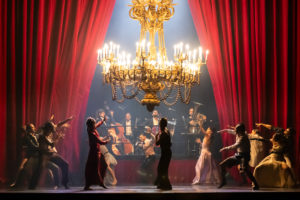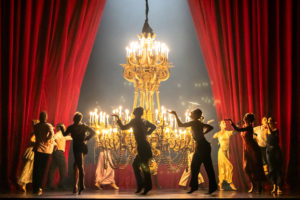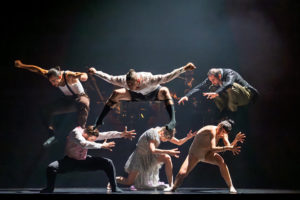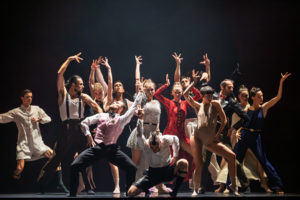There was great excitement for the Red Carpet, the new dance from choreographer Hofesh Shechter. “For me, a red carpet first evokes thoughts of glamour.” However, the movements and appearances of the dancers are not glamorous. The choreographer also describes it as “grotesque.” Both are fitting. The major patron of the Paris Opera is Chanel. The costume designs come from CHANEL, and the dancers are from the Paris Opera Ballet. Shechter juxtaposes glam and art; which does the audience want most? Is the glam a sham? The dancers roll their bodies, step over each other, drag themselves or others. They form a circle around the stage with arms stretched high or arms bent in running position. This is more like a mosh pit; dancers are on top of each other or using their arms to create a form. The music came from live musicians who were on the stage but not continually seen.
I wonder whether Shechter is ironic as he speaks about glam vs. art. Can they be the same? Is he noticing what it takes to achieve glam or art? One can certainly do what is claimed to be glam art. Shechter says, “In contemporary dance, the stage is filled with references and expectations…I don’t believe the role of dance is to provide solutions. A ballet must remain open, unresolved; that’s its beauty.”

Paris Opera Ballet’s North American Premiere of Red Carpet by Hofesh Shechter at Cal Performance Zellerbach Hall, photo credit: Chris Hardy
Shechter may have noticed the use of the arms in Alvin Ailey’s Company. In Revelations, the dancers are in a sunburst shape with different sets of arms opening with start-stop rhythm. Probably the first dancer/choreographer to gather dancers in that shape and set their arms opening was Anna Sokolow. “Her choreography of intertwining groups with reaching arms influenced Alvin Ailey (who danced in her Poem) and Jerome Robbins.” Poem was Sokolow’s taboo challenging dance in which dancers touched each other: “her dancers actually touched, sometimes in what could be homosexual embraces.”* I am not suggesting his movements were taken from other choreographers, but visual material lives on. In Red Carpet, the movements seem to be decadent folk dance or natural movements which are alien to technique, ballet or contemporary technique, yet it takes some training to let go. Crawl. Bend over with your back parallel to the floor. Curiously, there were no leaps. Occasionally sort of a hop on one foot with the other leg bent at the knee. There was also a certain version of belly dancing.

Paris Opera Ballet’s North American Premiere of Red Carpet by Hofesh Shechter at Cal Performance Zellerbach Hall, photo credit: Chris Hardy
Contemporary dance traditionally undid traditions, but there is danger in not doing, let’s say Cunningham work, when it reigned and earned grants for the followers. Shechter’s Red Carpet may introduce new ways to produce dance. The first part of Red Carpet showed the dancers in Chanel costumes; someone seated near me commented that they looked like outfits in a resale shop. Being supported by Chanel gives the event glam, but is that superficial pretending? I think that Shechter knew what he is doing. The dancers perform in groups; often it is all thirteen dancers or a group of four or five. I cannot remember more than one or two times when a dancer stood apart from the group, but he will soon be absorbed by the rest. There is also pas de deux dancing, but it happens within the entire group. The costumes make different presences in which the audience can see them, but they are still in the group. Sometimes they are doing the same movements as others or expose their different movements within the group. One costume was a lacy gown with one part of the skirt hanging like a short column half in front of the legs and the other half missing. There was a black dress which looks sequined from a distance. It also had missing spaces of dress.

Paris Opera Ballet’s North American Premiere of Red Carpet by Hofesh Shechter at Cal Performance Zellerbach Hall, photo credit: Chris Hardy
The second half of Red Carpet alters the vision. The dancers are in colored white-flesh tights and body covers more or less. Some have Bermuda shorts length; others more. In this part of the dance, a group of 5 work on the floor rolling and reaching. There seems to be communication through the bodies though they are not always connected to others. There were a few times when it seemed to me they looked like Grecian figures on their vases. Were these dancers armed or simply digging into life? As Shechter said, solutions are not to be found

Paris Opera Ballet’s North American Premiere of Red Carpet by Hofesh Shechter at Cal Performance Zellerbach Hall
One special performer was the giant chandelier. It went up very high and also lowered to just above the stage floor. It did not crash like its cousin the chandelier in The Phantom of the Opera, but it had character. The Phantom’s chandelier was a replica of the chandelier of the Paris Opera House. It would not dare to crash upon the thirteen dancers from the Paris Opera Ballet.
The excitement continued throughout the performance. Red Carpet will be remembered as we await the next Shechter production.
*The Hedgehog, The International Arts Review, Vol. 5, No. 1, November, 2010) pp 4-5.